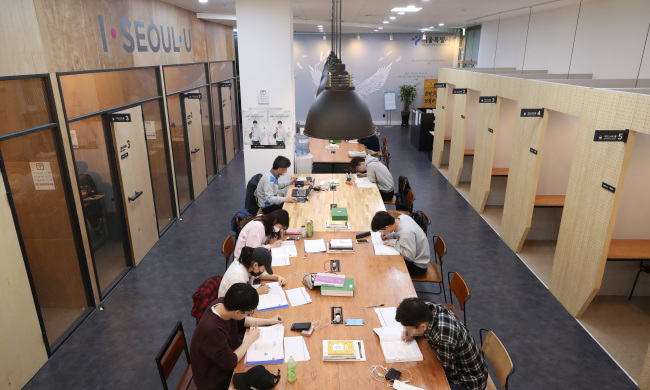A slump in private consumption and worsening unemployment are raising questions about the relevance of the Moon Jae-in administration’s income-led growth policy.
According to data released by the Bank of Korea last week, the ratio of personal consumption expenditures to the country’s gross domestic product stood at 48.1 percent last year, the lowest since related data began being compiled in 1970.
The ratio, which hovered above 70 percent in the 1970s, slid to 53.8 percent in 2000, 49.3 percent in 2015 and 48.7 percent in 2016.
Economists note private consumption has accounted for a diminishing part of Korea’s GDP in recent years mainly because people hold back on spending out of concerns over unstable jobs and an uncertain future. On the other hand, prior falls in the proportion were attributed largely to the nation’s economic expansion through increased investment and trade.
Even if the weakening propensity to consume is considered, the continuous decline in the ratio of personal consumption to GDP since the Moon administration was launched a year ago is beginning to call into question its policy to bolster growth by expanding fiscal expenditure to create more jobs and support wage hikes.
Last week, it proposed a 3.9 trillion won ($3.65 billion) supplementary budget aimed at creating more jobs for young people after implementing an 11 trillion won extra budget designed to boost employment last year.
Affected by Moon’s campaign pledge to raise the wage floor to 10,000 won per hour by 2020, the hourly minimum wage for this year was up 16.4 percent from 2017 to 7,530 won.
“What the slump in private consumption basically means is that jobs and income are not shoring up spending,” said Kim Kwang-seok, professor of economics at Hanyang University in Seoul.
“The government has been pushing for income-led growth, but the policy does not seem to bring about the intended results.”
The country’s unemployment rate was up 0.4 percentage point from a year earlier to 4.5 percent in March, the highest for the month in 17 years, according to data released by the state statistics office Wednesday.
The youth jobless rate stood at 11.6 percent last month, compared to 11.3 percent the year before.
The number of employees in the sectors of retail, restaurants, accommodation and educational services decreased by more than 170,000 on-year in March, as employers cut payrolls to cope with wage increases.
Separate government data showed that real household income rose 1.6 percent in the final three months of last year after continuing to fall over the previous eight quarters.
But the modest income increase is being offset by a rise in the price of items closely linked to people’s livelihoods, which has been fueled by the minimum wage hike.
Consumer prices rose 1.3 percent from a year earlier in March. But eating out expenses and the price of agricultural and fishery products gained 2.5 percent and 4.7 percent, respectively.
Market watchers say that while the government is keeping close tabs on price hikes, a growing number of businesses burdened with higher wages are moving to raise prices on goods and services they are offering.
They note the minimum wage increase has not only affected individual businesses, which have been forced to pass on the burden to customers, but the whole distribution sector.
The prospect for additional interest rate hikes this year is also holding back heavily indebted households from increasing consumption expenditure.
The country’s overall household debt grew 8.1 percent last year to surpass 1,450 trillion won, while household income rose 4.5 percent in nominal terms.
Accordingly, the ratio of household debt to disposable household income soared to a record high of 159.8 percent.
Economists note the shrinking proportion of private consumption could deprive the Korean economy heavily dependent on exports of a buffer against the impact from a sharp drop in outbound shipments.
Comparisons to other major economies show the ratio of private consumption to GDP is relatively low in Korea.
As of 2015, the corresponding figure was 68.1 percent for the US, 64.9 percent for the UK, 56.6 percent for Japan and 53.9 percent for Germany, compared to Korea’s 49.3 percent.
Calls are now growing for the Moon administration to reconsider its policy to increase jobs and wages through fiscal expansion and other measures that have put heavier burdens on companies.
Economists say it needs to focus on deregulation and labor reforms to help boost corporate investment and productivity, noting government-subsidized employment programs are ineffective and unsustainable.
Enhancing labor productivity holds the key to creating more decent jobs and enabling workers to take home more income.
“Low productivity, along with a reduction in the working-age population, is threatening to weaken the country’s growth potential,” said Yang Seo-young, a researcher at the Korea Development Bank.
Korea remains near the bottom among major economies in terms of labor productivity.
Korean workers produced added value worth $33.1 on average in 2016, which was 52 percent, 55 percent and 79 percent of the output by their peers in the US, Germany and Japan, respectively.
The country’s labor productivity is particularly low among workers in the service sector and at small and medium-sized enterprises.
Service industries’ productivity remained at 51 percent of that for manufacturing industries in 2015, and SMEs’ productivity was just 32 percent of the level of large companies in 2016.
Economists also note the Moon administration should readjust the pace of increasing the minimum wage and reconsider other pro-labor measures that have increased corporate costs and driven low-wage workers out of their jobs.
By Kim Kyung-ho (
khkim@heraldcorp.com)








![[Today’s K-pop] Blackpink’s Jennie, Lisa invited to Coachella as solo acts](http://res.heraldm.com/phpwas/restmb_idxmake.php?idx=644&simg=/content/image/2024/11/21/20241121050099_0.jpg)